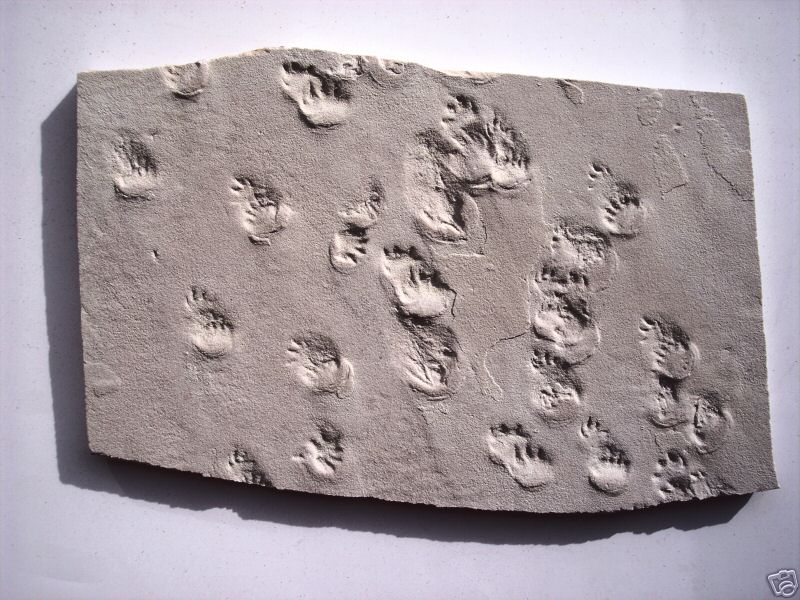
Part of Kuban's Paluxy website

|
| Permian mammal-like reptile tracks, Arizona
|
Among the compelling lines of evidence refuting Flood Geology are a wide variety of trace fossils or "ichnites," which are any impressions or structures made by ancient organisms while they were still alive. Said another way, trace fossils are geologic records of biologic activity. These include trackways, burrows, dens, nests, droppings, and feeding marks left by a variety of vertebrates and invertebrates throughout much of the fossil record (Martin, 1999; 2010).
Many of these trace fossils must have been made on dry land, or under at most shallow water, and in relatively calm, mild conditions--hardly the kind of environments expected during a torrential global deluge. Appeals by some creationists to "lulls" during the Flood, or differential escape abilities of different animal groups, are incapable of explaining the widespread geographic and geologic prevalence of trace fossil, and many of the features of specific ichnites.
Many creationists suggest the strata containing these trace fossils represent the middle or latter stages of the Flood. However, the Bible itself, which many Flood Geologists cite to support their position, states that all animals died in the first 40 days of the Flood. If the Flood was global and not regional, as Flood Geologists insist, there would have been no animals alive to make the trace fossils observed.
Flood Geologists must explain how all these complex structures, which typically require mild and dry (or at best shallow water) conditions, specific environmental resources and materials, and significant periods of time, were formed during a violent global flood. YECs themselves often characterize the Flood as having unprecedented hydrologic forces. Such conditions would have destroyed most if not all potential trackmakers during its early stages, as well as the animals' original habitats. Yet at many trace fossils sites we see abundant evidence of such habitats, not only in the trace fossils themselves, but also a variety of other indicators (such as mud cracks, ripple marks, etc.) demonstrating relatively calm, mild, non-Flood conditions. Let us examine some specific examples.
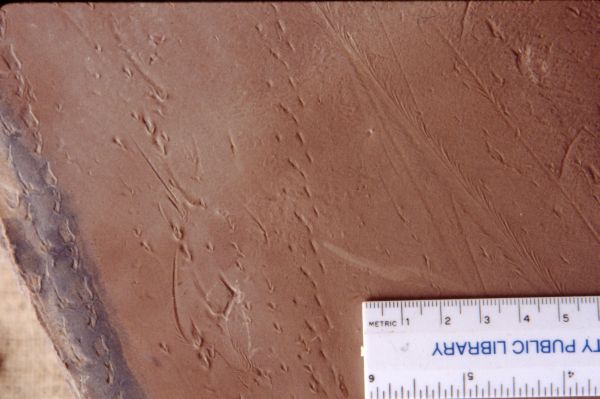
|
| Permian invertebrate trails, southern New Mexico. © 1991, Glen Kuban |
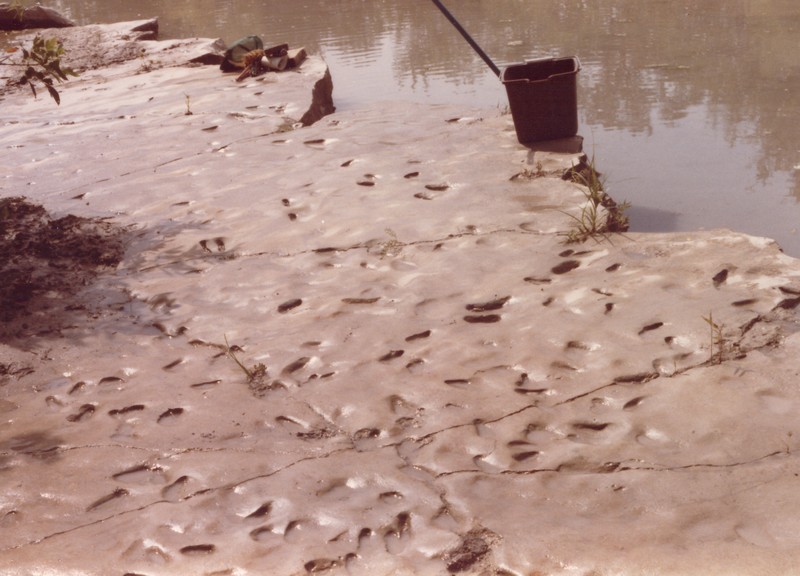
|
| Lower Cretaceous crustacean burrows on ledge above Taylor Site, Glen Rose Texas © 1980, Glen J. Kuban |
Although Glen Rose is most famous for the well preserved dinosaur tracks the formation bearing the tracks also displays a variety of invertebrate trace fossils. Some of these, generally associated with the ichnogenus Diplocraterion, are U-shaped burrows that appear as barbell-shaped impressions from the surface, and which are believed to have been made by shrimp-like animals. A hard limestone "marker bed" above the track layer in the Paluxy Riverbed west of Glen Rose that extends for several square kilometers (and probably farther). Literally tens of thousands of such burrows can be viewed on the exposed surfaces, and this is probably a small fraction of the borrows that exist on the surface (much of which is buried). The issue is not just how long it took these burrows to be made (probably at least days), but how all these creatures managed to survive the Flood until this point, and stay together or recongregate with so many members of their species before forming all the burrows. Note that the upper ends of these burrows are open to the air, as are many invertebrate burrows today, are were clearly not made underwater, nor under layers of other sediment. In the mainstream view, there is no problem, as this would have represented the organisms' normal mud-flat environment, and the margin of a large shallow sea.
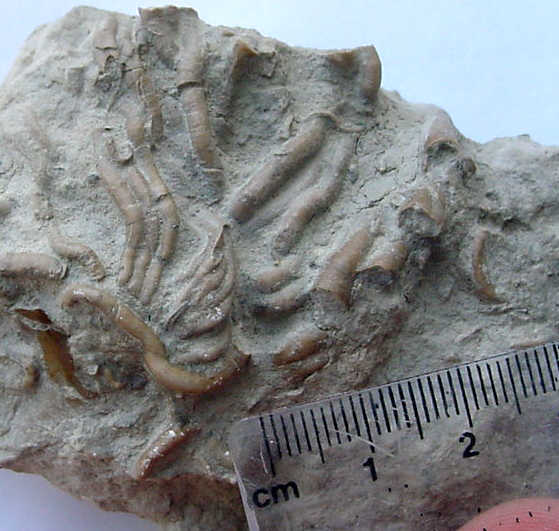
|
| Serpulid Worm Tube Fossils Lower Cretaceous, Central Texas. © Glen Kuban |
Many additional examples of extensive, complex burrow systems are discussed by Glenn Morton (2003). Morton emphasizes that a wide variety of burrows are found in immense numbers throughout the fossil record, and that many of the burrows are clearly not "escape burrows" as some YECs claim. He also notes that typically the burrowing creatures appear to be in no particular hurry or distress while making their countless traces. The same can be said for the next large group of traces to be discussed: Vertebrate trace fossils.
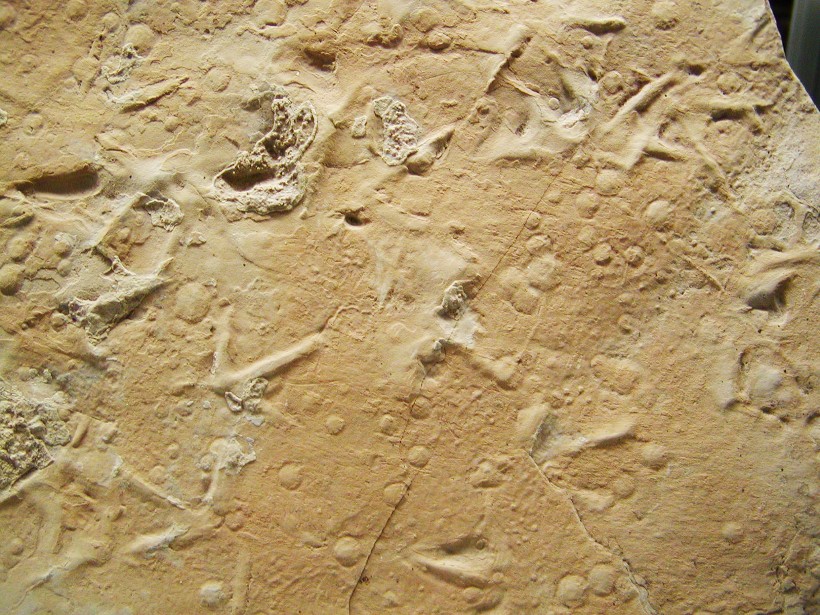
|
| Ancient bird tracks and rain drops Eocene, Green River Formation, WY |
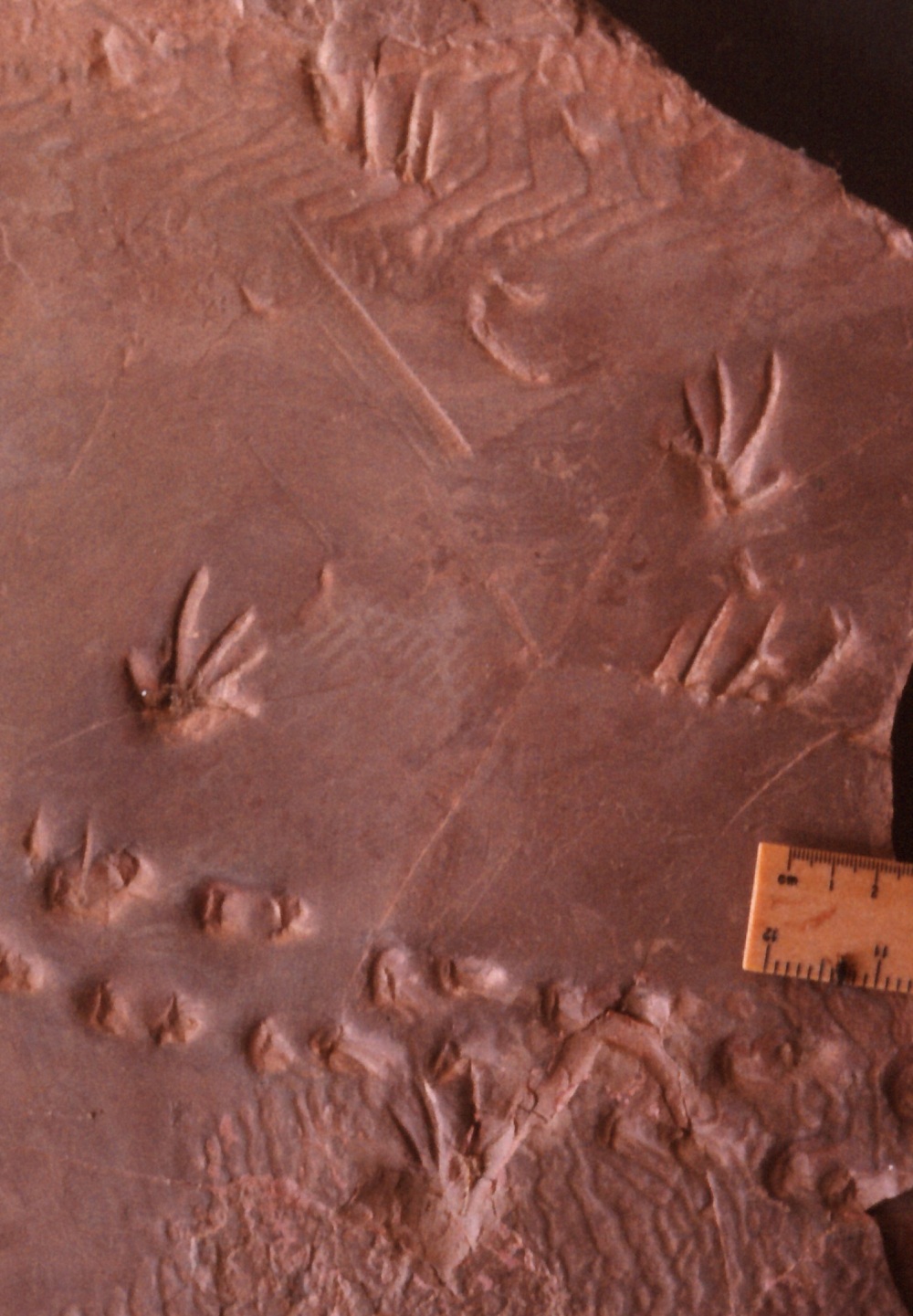
|
| Permian lizard tracks from southern New Mexico. © 1991, Glen Kuban |
2. The sheer numbers of tracks and tracksites. Thousands of fossil tracksites are known, collectively containing billions of tracks, and hundreds of species of dinosaurs and other prehistoric animals. Some tracksites extend for many square kilometers. Creationists cannot explain how such tracks were made in the midst of a violent global deluge, or why, if somehow so any prehistoric animals managed to do so, so many modern species failed to do so. Alleged exceptions such as supposed "human" prints in Mesozoic rocks of Texas and Arizona have not stood up to close scrutiny (Kuban, 1986, 1989, 1992).
3. Multiple track beds at individual sites. On many sites one finds tracks of highly variable depth even for similar sized animals, and/or tracks on multiple bedding planes--indicating that the dinosaurs walked there more than once and over an extended period of time. For example, Kevin Henke (2004) discusses the problem of dinosaur tracks occurring on multiple members of the Jurassic Morrison formation surrounding Dinosaur National Monument, and along with other geologic features inconsistent with a global flood. Similarly, dozens of tracks are known on several different horizons in Cretaceous rocks of Texas. Again, the tracks show numerous dinosaurs, of at least three types.
4. Trackmaker gaits and directions. Most vertebrate tracksites with multiple trails show animals moving in a variety of directions, and at normal, healthy paces--not running, stumbling, or laboring as would be expected if they were trying to escape onrushing or encroaching Flood waters. Indeed, although some creationists have suggested that most trackways indicate running animals, the evidence is the exact opposite: running trails are relatively rare.
5. Track preservation. Some creationists have claimed that rapid burial during a global flood explains track preservation. However, the opposite is closer to the truth: tracks benefit best from gentle burial (whether slow or not). The kind of violent deposition that would occur during a global flood would tend to mar or destroy any tracks, not preserve them. In contrast, tracks at many sites are remarkably detailed, suggesting that they were buried gently with a contrasting sediment, and in many cases experienced a period of drying before burial. Furthermore, as mentioned earlier, mud cracks found at many track sites provide direct evidence that the track surface was dry for some time (probably days or longer) before burial.
6. Tracksite ecology. At some track sites we see evidence of entire ecosystems, with a variety of invertebrate and vertebrate tracks found together, and predator/prey species interacting.
7. Geological distributions of tracks. Numerous terrestrial vertebrate tracksites are known from the Permian period onward. They also correspond well with body fossils, meaning that each period of geologic time features characteristic animals as well as corresponding track types. For example, dinosaur tracks occur in all three periods of the Mesozoic era, but not in stratigraphically higher or lower strata. Large mammal tracks occur in the Paleocene and more recent periods, but not earlier. Pterosaurs (flying reptile) bones and tracks only appear in Mesozoic rocks. There is no reason why this should be the case in a Flood Geology framework.
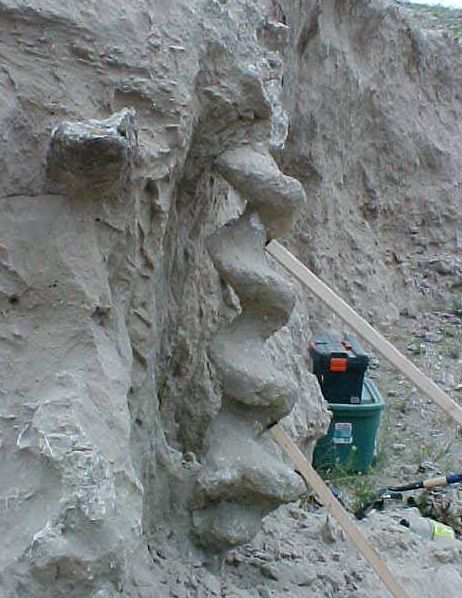
|
| "Devil's Corkscrew" borrow made by beaver-like rodent (Miocene, Nebraska) Credit: Terry Proctor |
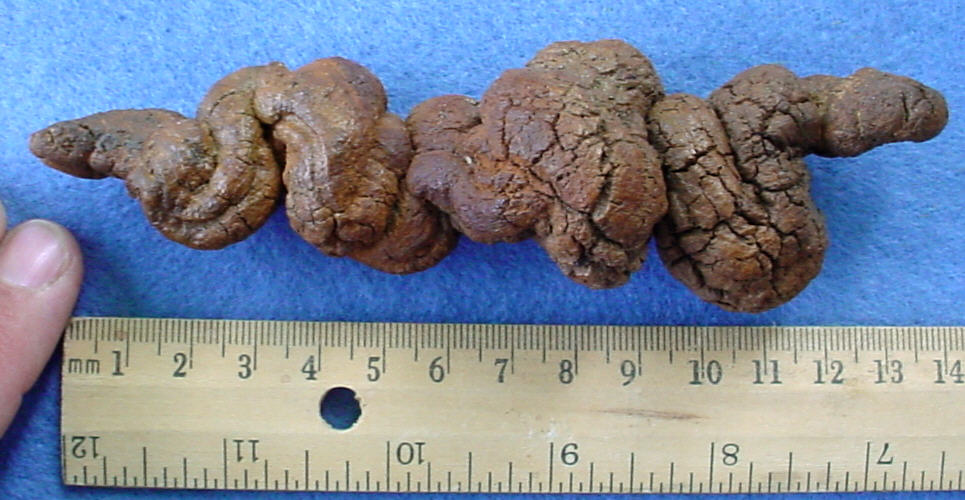
|
| Cprolite (Fossilized dung). Probably tortoise Miocene Epoch (Approx. 22 million years) Washington state |

|
| Dinosaur nest. Oxford Museum of Natural History |
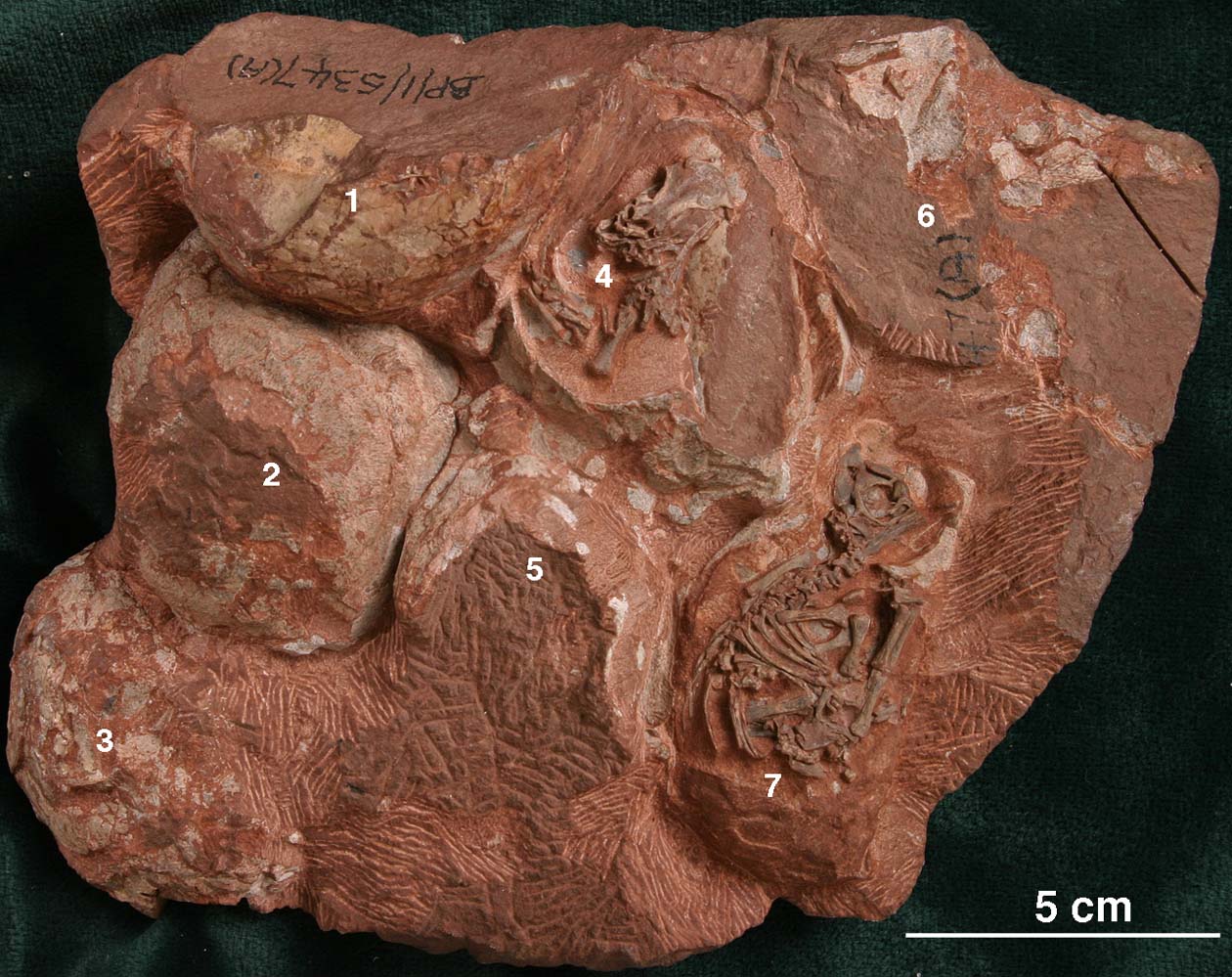
|
| Dinosaur nest from Lower Jurassic of South Africa, showing embryos in some of the eggs Credit: D. Scott |
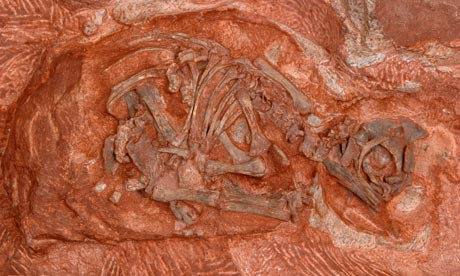
|
| Massospondylus prosauropod embryo, South Africa Photo credit: D. Scott. |
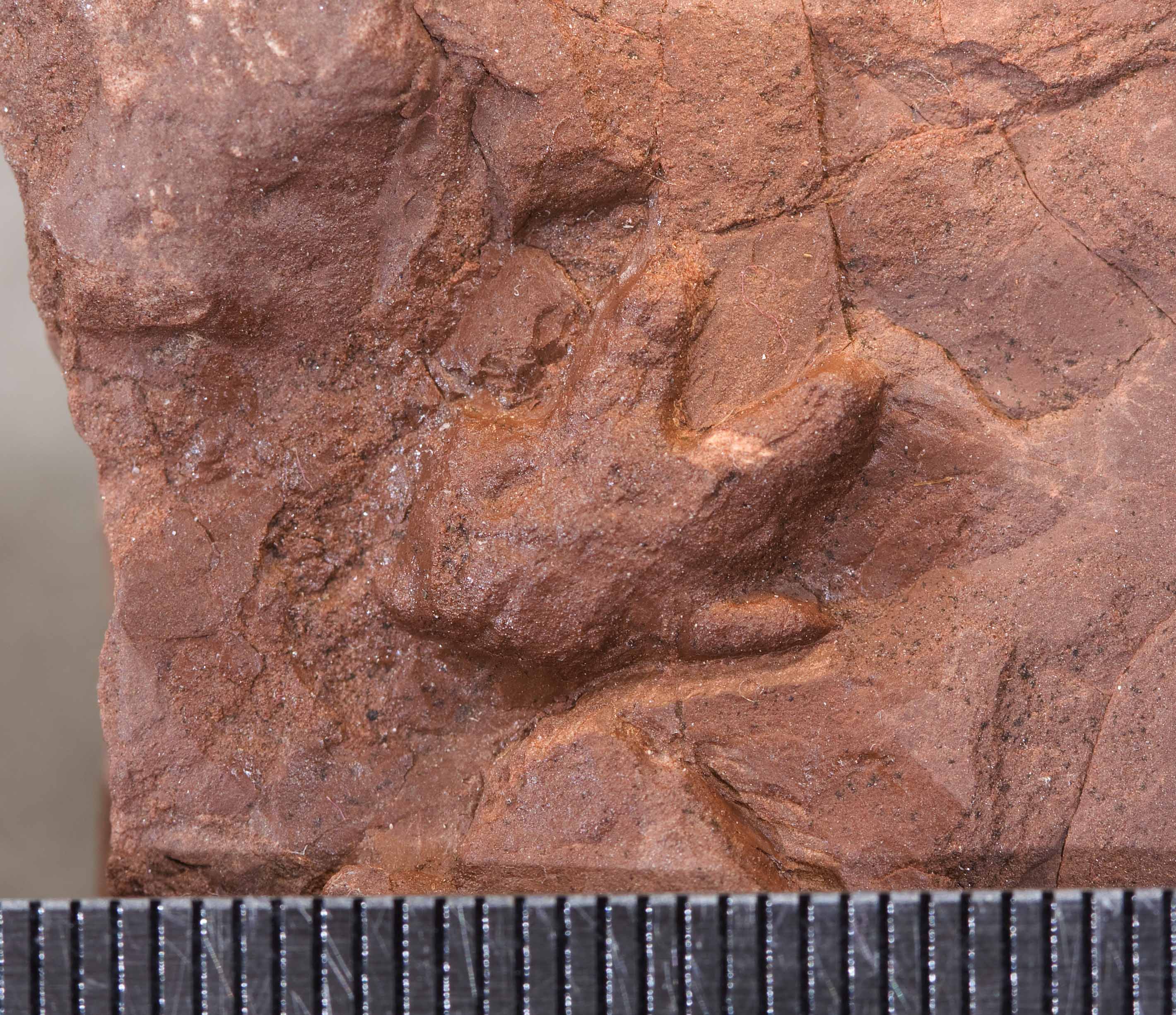
|
| Baby dinosaur track, S. African nesting site Credit: D. Scott |
The following example by John Stear accentuates the magnitude of the problem for Flood Geologists. "Thousands of sauropod eggs have been discovered from a site at Auca Mahuevo, Argentina (Chiappe et al, 2001). This site is interesting because several of the eggs are unhatched and preserve sauropod embryos. The eggs at this site are found at 4 or 5 separate levels, and are preserved in a type of paleosol called a vertisol. Vertisols develop in clay soils subjected to repeated wetting and drying, which causes the clay soil to swell and then shrink, forming "slickensides" along sheer planes within the soil. Since vertisols only form in semiarid or seasonally arid climates, this too is inconsistent with the flood." Later Stear notes: "In Mongolia an Oviraptor was preserved directly on top of a clutch of eggs, in what appears to be a "brooding" position. Dinosaur eggs which have hatched demonstrate temporal breaks in sedimentation long enough to rule out the flood model all by themselves, because they show that the eggs were laid and subsequently remained unburied long enough for incubation to be completed" (Stear, 2005).
When we consider the number of such sites and the multiple strata, at which they are found in some localities, and the problem for Flood Geology is compounded many fold. Making matters even worse, Reisz et. al (2012) documented a nesting site with multiple layers in South Africa, and with juvenile tracks found around the nests in several growth stages, some double the size of the hatchling prints. This indicates that the dinosaurs returned repeatedly to lay and hatch eggs, and that the young stayed near the nests for some time --certainly many weeks or more. None of this is remotely compatible with a global Flood scenario. Rather than face the clear implications of this evidence, some YECs have resorted to truly ridiculous proposals, such as the suggestion by Walter Barnhart that dinosaur nests were made under water, during rising flood waters. He further suggests that eggs with openings were not from hatching, but hot water bursting the eggs. Of coruse he did not explain the developed embryos in many eggs, or how babies managed to grow and make footprints around nests, all while under water, and "hot water" no less. From any frank appraisal of the evidence, it is is clear that what is really in hot water is the YEC viewpoint.
Even if YECs could explain how all the above things took place during a violent worldwide Flood, severe ecologic problems remain. Dinosaurs, like most animals, undoubtedly required specific environmental conditions for mating and nesting. So even if they somehow managed to tread water for weeks or months without even fresh water to drink, and even if areas of exposed land existed for additional weeks or months during the midst of the Flood (which contradicts YECs own literal reading of the FLood account), all of the dinosaurs' normal habitats would have been thoroughly destroyed, leaving entirely foreign and unsuitable climatic conditions, sediment, and (if any existed at all) vegetation, and again, not even fresh water to drink. Trying to reconcile this with all the track and nesting evidence described above is like arguing that sharks and tuna fish reproduced on desert sand dunes.
Yet another priblem not explained by Barnhart or other strict creationists concerns the preservation of the eggs and nests. In order for delicate structures such as eggs and nests to be preserved largely intact, deposition would need to occur in a relatively calm, low-energy manner. In contrast, a number of Flood Geology proponents have argued that the Flood waters would have produced tremendous current speeds of 90 to 180 mph (Barnette and Baumgardner, 1994; Woodmorappe, 2002).
A following proposals have been advanced to reconcile trace fossils with Flood Geology; however, all fail miserably.
1. Hydrologic sorting. First, tracks and trails are usually on intact beds, and thus do not sort. Second, any hydrologic sorting of body fossils makes the problems worse for Flood Geology. Such sorting would tend to group animals of similar size and density together, including many large mammals and similar sized dinosaurs. And yet they are never found together, nor even at the same geologic horizons. Mammal-like reptile tracks are consistently found stratigraphically below dinosaur tracks. Dinosaur and pterosaur tracks are consistently found below large mammal tracks. The same kind of succession occurs for corresponding body fossils.
2. Ecological zonation. This would at best explain horizontal segregation, not the consistent vertical succession seen in the fossil record. It also does not explain the conditions found in the midst of, or immediately after, a global flood, which would destroy the original environments and ecosystems.
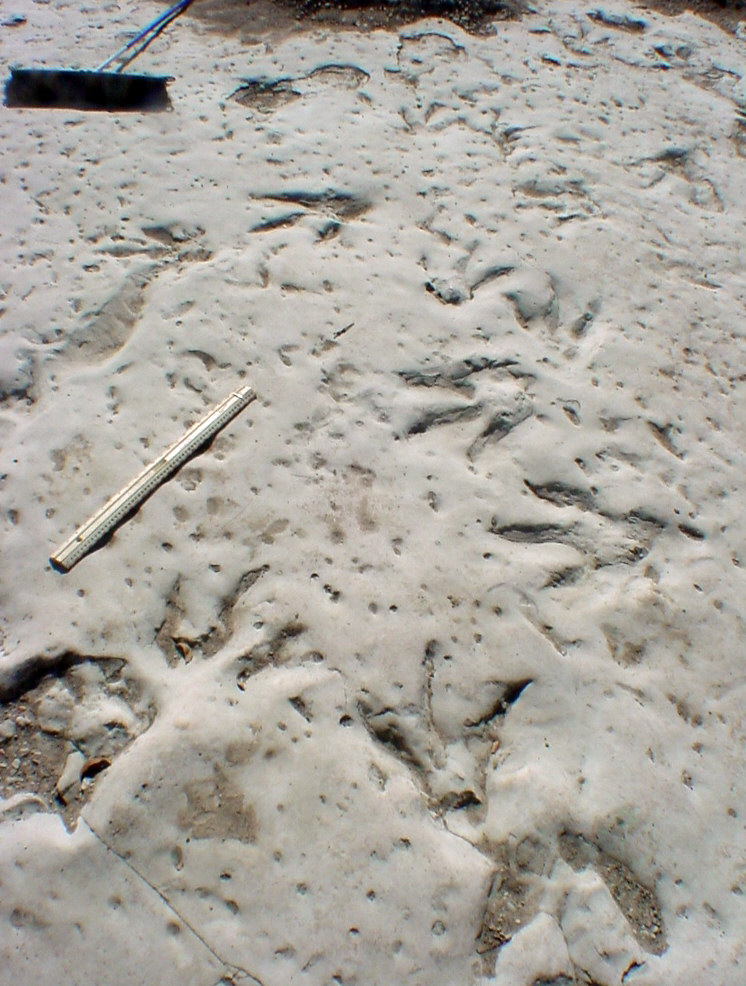
|
| Lower Cretaceous theropod dinosaur tracks,
Central Texas
© 2006, Glen J. Kuban |
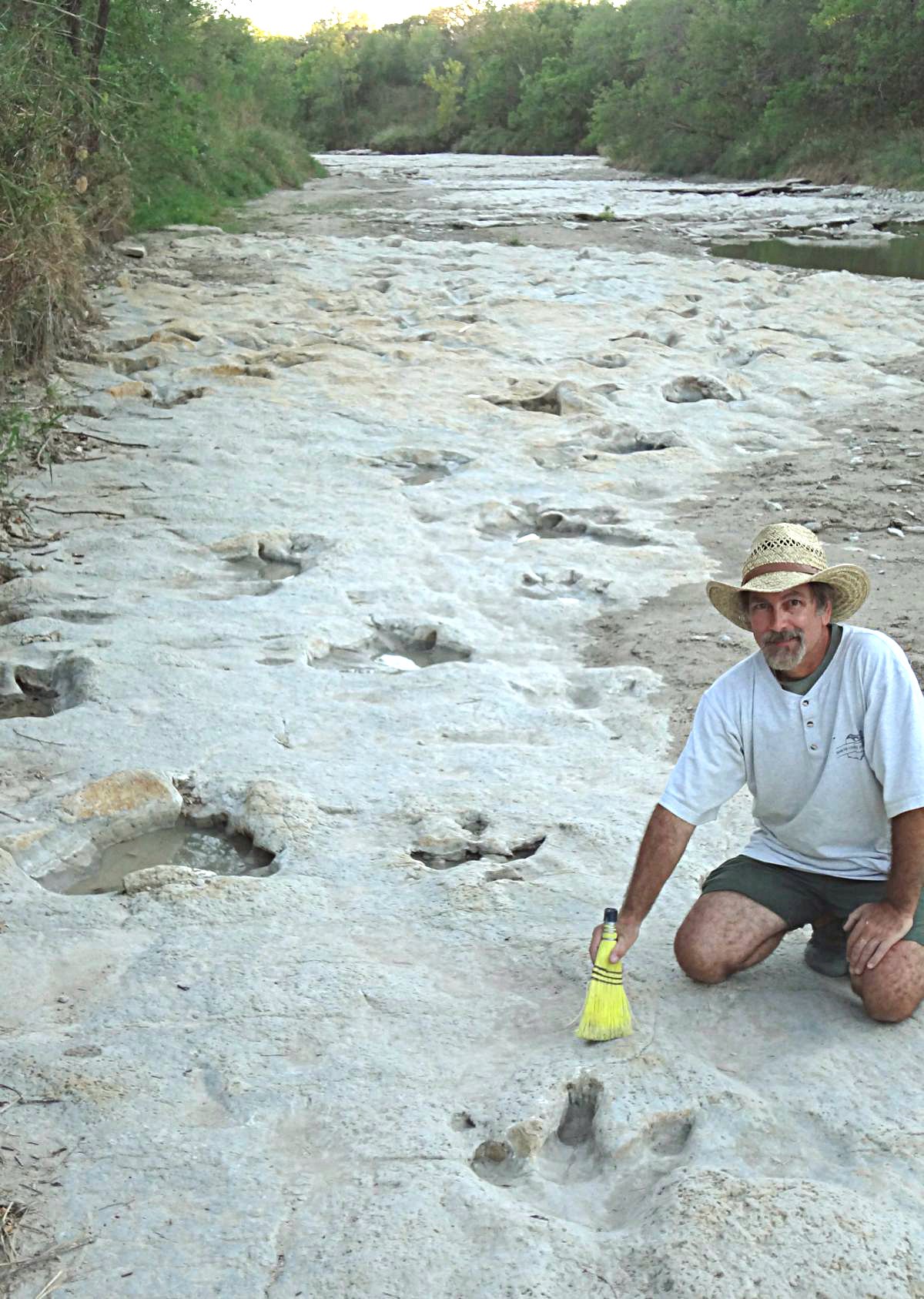
|
| Parallel trails of sauropod tracks,
interspersed with theropod tracks, Lower Cret., Glen Rose, Texas © 2011, Glen J. Kuban |
3. Differential escape abilities. First, even if dinosaurs were all slow, lumbering beasts (a long discredited notion) it would not explain why their bones and tracks consistently appear after a variety of Permian animals. Second, the evidence shows that dinosaurs, like mammals, were a diverse group and included many small and gracile, quick-footed species, so there is no basis for suggesting that all dinosaur remains and tracks should appear below all large mammal remains. Especially problematic for the escape ability suggestion is why the remains and tracks of pterosaurs (flying reptiles) also consistently appear below mammal tracks, and never in Cenozoic strata.
4. Lulls in the flood waters. The number and length of proposed "lulls" in the flood waters makes them incompatible with a violent global flood, which represents the core of Flood Geology. Indeed, many creationists authors such as John D. Morris (president of ICR) have emphasized the "rapid and continuous" nature of Flood deposition. The proposal also does not explain how thousands of vertebrate and invertebrate creatures that left fossil tracks the world over survived while underlying sediments (often hundreds of feet worth) were being deposited. The "lulls" explanation is especially untenable when phenomena such as vast dinosaur nesting sites are considered, which require at least weeks of non-deposition, as well as the preservation of ecological conditions suitable for mating--which could hardly be the case after weeks of violent flood deposition.
5. Non-Flood deposits. Garner (1096) and a few other creationist authors have tried to deal with these problems for Flood Geology by proposing that many trace fossil depositions were post-Flood. However, this contradicts the claims of most other creationists that the Mesozoic Era (Triassic, Jurassic, and Cretaceous Periods) represents Flood deposits, and leaves other serious problems of its own. One is the inability to explain why there is a specific and consistent order around the world in the track and bone finds in the Mesozoic. Not only do the trackways correspond to the body fossils, but we find no tracks or bones of most large, modern mammals in the Mesozoic Era--even though according to Flood Geology they were all living at the same time. Indeed, despite the occurence of millions of dinosaur tracks and body fossils in the Mesozoic, we find no evidence (either as tracks or body fossils) of horses, deer, cattle, camels, elephants, rhinos, dogs, cats, bears, hippos, giraffes, apes, whales, apes, humans, or scores of other modern mammal groups), even though they must all have existed after the Flood, since they are still with us. This major problem is seldom acknowledged let alone adequately explained by creationists addressing trace fossils. At the other extreme of Flood Models, some creationists have proposed that dinosaur trace fossils might represent pre-Flood phenomena. However, this position is unpopular even among creationists, since most Mesozoic layers, including most track and nesting sites are underlain by hundreds or even thousands of feet of sedimentary strata. Moreover, a pre-Flood proposal is just as impotent as post-Flood interpretations in accounting for the corresponding successions of tracks and body fossils throughout the world.
6. Misidentifications. One of the weakest attempts to harmonize vertebrate tracks with young earth creationism was made by John Woodmorappe (2002), who suggested that many supposed dinosaur tracks may have been made by fish or other aquatic animals. He based his comments on a report regarding some indistinct, putative dinosaur tracks at Isona, Spain which have been reinterpreted as possible manta ray traces (Martinell et al, 2001). However, Woodmorappe's comments are largely moot, since whatever the status of the Isona tracks, thousands of sites throughout the world show distinct, unmistakable tracks of dinosaurs and other terrestrial vertebrates. Even some strict creationists have criticized Woodmorappe's remarks on this basis, while emphasizing additional challenges for Flood geologists:
The sediment pile above which tracks occur is commonly many kilometers thick. We are unable to conceive of a Flood so catastrophic as to lay down kilometers of sediment while at the same time allowing terrestrial animals 'temporarily to survive' that catastrophe. If a few trackways would be hard to reconcile in such a scenario, let alone the millions of well documented terrestrial tracks on thousands of sites around the world. This difficulty is further compounded by the frequent occurrence of dinosaur tracks at successive horizons at the same locality (Garner et al, 2003).Other creationists boldly assert that not only are trace fossils not a problem for their views, but that they are acutally better explained in a global flood scenario than mainstream geology. However, those asserting this greatly oversimplify or neglect many aspects of the evidence.
YEC advocate John Woodmorappe (2006) tried to resolve the problem of invertebrate burrows with two main arguments. One is that many fossil burrows might have been made more quickly than generally assumed. However, he neglects many kinds of invertebrate trace fossils (trails, hives, nests, etc) that could not have been made while deposition was taking place, and which, regardless of the time required for their formation, were clearly made in relatively dry and/or calm environments, or other conditions inconsistent with a global Flood scenario. Curiously, Woodmorape repeatedly uses the terms "ichnofossils" and "trace fossils" as if they referred only to invertebrate traces, and mainly to marine invertebrate burrows, whereas both terms actually include any fossil remains (whether vertebrate, invertebrate, plant, or microbial) made by an organism while it was still alive. As noted above, his earlier effort to explain vertebrate footprints was similarly incomplete and unsuccessful. Woodmorappe's second argument about fossil burrows is that many may be misidentified body fossils or inorganic sedimentary structures, and unambiguous biogenic origin are "rare." However, this is quite misleading. Although there are many possible trace fossils of uncertain origin, even if one removes from consideration all questionable specimens, it still leaves millions of specimens that are clearly made by organisms, and they are found at thousands of sites and geologic horizons throughout the world. As illustrated earlier, in central Texas alone, we find multiple beds densely covered with U-shapped burrows, thousands of surpilid worm tubes, and thousands of vertebrate footprints. In these cases and countless others, the trace fossils cannot be dismissed as inorganic structures or body fossils.
Another YEC, Michael Oard (2003), begins an article on fossil tracks by stating that according to "evolutionists" dinosaur tracks were made "some hundred million years ago." Actually, dinsosaur tracks occur at many horizons throughout most of the Mesozoic era, from mid Triassic through late Cretaceous-- approximately 235 to 65 million years ago. Oard need not accept these dates, but he ought to learn and accurately convey what mainstream scientists actually hold. Oard next argues that most dinosaur trackways are straight, and that this suggests the trackmakers were running from on-rushing flood waters. This is a silly argument. While some dinosaur trails are relatively straight, most curve at least somewhat, especially when followed for more than several steps. Moreover, the proportion of curved to straight trails are about the same as modern trackmakers, which are clearly not running from onrushing flood waters. More importantly, if most trackmakers were trying to escape onrushing waters, one would expect most to be heading in the same direction, and often staggering or laboring from exhaustion and distress. In contrast, most dinosaur tracksites with multiple trails show animals moving in a variety of directions (except where there is evidence of an ancient shoreline or migrating herds), and walking in a normal, healthy, unhurried fashion. YECs would have trouble explaining even a few trackways in the midst of a global FLood, let alone thousands of trackways at thousands of horizons throughout the world. Visual confirmation of these points can be found in many books and articles on dinosaur tracks, especially those that show detailed site diagrams and trackway photos, such as Farlow (1987), Farlow et al (2011), Lockley (1991), Gillette and Lockley (1989), Kuban (1986a, c, d), Thulborn (1990). Even if YECs could explain how all the dinosaur trackways and nesting sites formed during a global deluge, they would also have to explain why thousands of large modern mammal species left no tracks or bones in the same strata. The few alleged exceptions once promoted by YECs, such as the Paluxy "man tracks," have been well refuted (Kuban, 1986, 1989, 1992; Hastings, 1989), and are no longer considered reliable even by major YEC groups.
Oard also argues that few juvenile tracks are known, and that this indicates that they were made under unusual conditions, such as a worldwide Flood. Again, both his facts and reasoning are flawed. A preponderance of large tracks is expected simply from a preservational bias against them. Small tracks tend to be impressed less deeply, and to erode more easily. Despite this, many small (and likely juvenile tracks) are known from many tracksites--often occurring near larger/adult tracks. Even tiny hatchling tracks are known, and as mentioned earlier, some nesting sites even show juvenile tracks of various growth stages), indicating that not only did the dinosaurs lay and incubate eggs, but also that the young stayed near the site for many weeks or more.
Oard makes the misleading comment that "Dinosaur tracks discovered in Queensland needed to be covered after excavation because they were eroding through exposure to the elements. So they couldn't have been exposed for millions of years." However, no mainstream scientist claims they were. All evidence (and common sense) indicates that after tracks were initially made and buried, they would have remained protected under sedimentary layers for most of geologic history, until reexposed in relatively modern times by the actions of rivers, erosion, or human excavators. Indeed, another issue not even addressed by Oard concerns track preservation. If the tracks were made on soft, wet sediments during a violent flood, and then buried with violent onrushing waves of water, few if any tracks would be preserved. Evidence indicates that the environments preserving tracks were far different - involving calm and gentle burial in most cases, and often a spell of drying before burial, as indicated by bud cracks in many track layers, and crisply preserved details in many tracks themselves Morton (2004b).
Oard's attempts to deal with dinosaur nests are even weaker. He suggest that eggs missing tops are probably due to predatory dinosaurs breaking them open to eat the babies, rather than to hatched eggs. Even if this were true, and there is no evidence for it, it would not only compound the problems for his position. He'd still have to explain how both the egg layers and predators survived weeks or months of raging flood waters, how the dinosaurs managed to mate, make nests, and lay eggs during a raging worldwide flood, and how countless fragile eggs and nests survived the next onslaught of flood waters. Further critiques of Oard's trace fossil claims were made by Konkus (2010a, 2010b).
Moreover, many other lines of evidence besides trace fossils also create severe problems for the YEC viewpoint. Billions of body fossils of vertebrtes, invertebrates, plants, and microfossils are are also found in patterns and orders that are far from those expected if all living things were created and living together only a few thousands of years ago, and if most perished during a violent worldwide Flood. Several authors from AIG have acknowledged that there are no well documented human remains in any Flood or pre-Flood sediments (Batten et al, 2006; Snelling, 1991); however, the problems extend far beyond human remains. For instance, no other large mammal remains have been reliably documented in any Mesozoic or Paleozoic sediments, even though in the YEC paradigm, countless thousands would be expected and readily documented among the billions of other fossils found in such strata.
Babinski (2002) provides a good summary of the interrelated geologic and trace fossil evidence that refutes Flood Geology. Noting that the geologic record documents a wide variety of ancient environments and not a year-long recent deluge, Babinski explains,
There are desert strata, dried out lake beds and dried up river beds, paleosols (soil horizons), layers of rootlets at different horizons in the geologic record, layers of forests at different horizons, fossilized ant nests, termite nests, fragile wasp cocoons, cells from bees nests, dinosaur nests and eggs, reptile nests and eggs (in the Chinle Formation of the Petrified National Forest), bird nests and eggs (of a relative of the flamingo in the Green River Formation in Wyoming), fossilized worm holes, fossilized rodent burrows, tracks, trails and markings left by land-dwelling animals, even animal dung in its original position of deposition as it dried and cracked and hardened on solid ground. The geological evidence is clear that dry land existed at many different periods throughout the past with land animals continuing to walk around, deposit dung, woo mates, build hives, nests and burrows, lay eggs, hatch those eggs ("empty hatched egg" fossils), then raise their young (and repeat the process), such evidence being found at different horizons in the geologic record. According to young-earth creationists such evidence all accumulated during an alleged "year-long Flood" that kept the earth under water for a year, and whose incomparable violence pulverized rock to fine sediment, then piled that sediment at an average depth of one mile over all the earth... "
Batten, Don, Ken Ham, Jonathan Sarfati, and Carl Wieland, 2006, Where are all the Human Fossils? Creation Magazine, Dec 91-Feb 92, Vol. 14, No. 1, pp. 28-33. Web version at: http://www.christiananswers.net/q-aig/aig-c014.html Note: Previously this article was found at www.answersingenesis.org/docs2/4419.aspa with authors listed, but now the URL redirects to the Snelling (1991) article.
Barnette, D.W. and Baumgardner, J.R., 1994. Patterns of ocean circulation over the continents during Noah’s Flood; in: Walsh, R.E. (Ed.), Proceedings of the Third international Conference on Creationism, Technical Symposium Sessions, Creation Science Fellowship, Pittsburgh, Pennsylvania, pp. 77-86.
Barnhart, Walter R. 2004. Dinosaur Nests Reinterpreted Evidence of Eggs Being Laid Directly into Rising Water under Conditions of Stress, Creation Research Society Quarterly, Vol. 41, No. 2. Sept. 2004, pp. 89-102.
Babinski, Ed. 2002. Creationist "Flood Geology" Vs Common Sense - Or Reasons why "Flood Geology" was abandoned in the mid-1800s by Christian men of science. Web article at: http://www.edwardtbabinski.us/babinski/flood.html
Brown, Walter T., 2008. In the Beginning: Compelling Evidence for Creation and the Flood, 8th Edition. Website at: http://www.creationscience.com/onlinebook/index.html
Carpenter, Kenneth, 1999. Eggs, Nests, and Baby Dinosaurs: A Look at Dinosaur Reproduction, Indiana University Press, 336 p.
Chiappe, Luis M. and Lowell Dingus, 2001. Walking on Eggs: The Astonishing Discovery of Thousands of Dinosaur Eggs in the Badlands of Patagonia, Scribner, New York, 224 p.
Cohen, Jennie, 2012, Oldest Known Dinosaur Nesting Site Was Also a Nursery. History in the Headlines web article at: http://www.history.com/news/oldest-known-dinosaur-nesting-site-was-also-a-nursery
Deem, Rich, 2008. The Genesis Flood Why the Bible Says It Must be Local. Website article at: http://www.godandscience.org/apologetics/localflood.html
Farlow, James O., 1987, Lower Cretaceous Dinosaur Tracks, Paluxy River Valley, Texas. SCGSA, Waco.
Farlow, James, M. Obrien, G. Kuban, et. al., 2011. Dinosaur Tracks of the Paluxy River Valley (Glen Rose Formation, Cretaceous), Dinosaur Valley State Park, Somervell County, Texas. Actas de V Jornadas Internacionales sobre Paleontologia de Dinosaurios y su Entorno, Salas de los Infantes, Burgos. Web version at: http://paleo.cc/paluxy/Farlow%20et%20al%202012%20Paluxy%20River%20tracksites.pdf
Garner, P. 1996. Where is the Flood/post-Flood boundary? Implications of dinosaur nests in the Mesozoic, Creation Ex Nihilo Technical Journal, 10, 101- 106
Garner, P., M. Garton, R.H. Johnston, S.J. Robinson and D.J. Tyler, 2003 (April). Technical Journal (now Journal of Creation), Vol. 17, No. 1, pp. 54-59.
Genise, Jorge F., 2000. Insects Palaeoichnology. Web article at: http://www.ub.edu/dpep/meganeura/53ichnology.htm
Gillette, D. D., and M. G. Lockley (Eds), 1989, Dinosaur Tracks and Traces. Cambridge University Press, New York, 454 p.
Godfrey, Stephen J., 1989. Tetrapod Fossil Footprints, Polonium Halos, and the Colorado Plateau NCSE Reports, Vol. 9, No. 2. (Winter 1989). pp. 8-17.
Hastings, R. J. 1988. The Rise and Fall of the Paluxy Mantracks. Perspectives on Science and the Christian Faith. Vol 40: 144-154.
Henke, Kevin R., 2004, Creationist Mumbo Jumbo at Dinosaur National Monument Web article at: http://www.noanswersingenesis.org.au/yec_mumbo_jumbo_henke.htm
Konkus, Sherry, 2010. Web site article at: http://www.stupiddinosaurlies.org/oard-s-foot-track-follies
Konkus, Sherry, 2010. Web site article at: http://www.stupiddinosaurlies.org/oard-s-flood-folly
Kuban, Glen J., 1986a, The Taylor Site Man Tracks. Origins Research, Vol. 9, No. 1, pp. 1-9.
Kuban, Glen J., 1986b, Review of ICR Impact Article 151, Origins Research, Vol. 9, No. 1.
Kuban, Glen J., 1986c, A Summary of The Taylor Site Evidence. Creation/Evolution, V. 6, No. 1, p. 10-18.
Kuban, Glen J., 1986d, Elongate Dinosaur Tracks. In Gillette, David D. and Martin G. Lockley, eds., Dinosaur Tracks and Traces, 1989, Cambridge University Press, Cambridge, pp. 57-72
Kuban, Glen J., 1989a, Retracking Those Incredible Man Tracks. NCSE Reports, Vol. 9, No. 4 (Special section.).
Kuban, Glen J., 1992, Do Human Footprints Occur in the Kayenta of Arizona? Origins Research. V. 14, No. 2, p. 7, 12, 16.
Kuban, Glen J., 2006a. Fossil Tracks and Other Trace Fossils Falsify Flood Geology. Web article at: http://paleo.cc/ce/tracefos.htm
Kuban, Glen J. 2015. Walter Brown's "Hydroplate" Flood Model Doesn't Hold Water. Web article at: http://paleo.cc/ce/wbrown.htm
Lockley, David, 1991, Tracking Dinosaurs: A New Look at an Ancient World, Cabridge University Press.
Martin, Anthony, 2010. Introduction to Ichnology. Web site at: http://www.envs.emory.edu/faculty/MARTIN/ichnology/
Martin, Anthony, 2010. Trace Fossil Image Database. Web page at: http://www.envs.emory.edu/faculty/MARTIN/ichnology/images.htm
Martinell et. al., 2001. Cretaceous Ray Traces?: An Alternative Interpretation for the Alleged Dinosaur Tracks of La Posa, Isona, NE Spain Palaios, vol. 16, No. 4 pp. 409-416
Morris, John D. 1980. Tracking Those Incredible Dinosaurs and the People Who Knew Them. Master Books.
Morton, Glenn R., 1997. Why the Flood is not Global. Web article at: http://home.entouch.net/dmd/gflood.htm
Morton, Glenn, 2003b. Burrows cause problems for the Flood. Web article at: http://wayback.archive.org/web/20120319194636/http://home.entouch.net/dmd/burrows.htm
Morton, Glenn R., 2004a. While the Flood Rages, Termites Dig, Dinosaurs Dance and Cicadas Sing. Web article at: http://home.entouch.net/dmd/termites.htm
Morton, Glenn R., 2004b. Tracks and Raindrop, Hail and Ice Impressions Demonstrates Slow Deposition Web article at: http://home.entouch.net/dmd/Tracks.htm
Morton, Glenn R., 2007. Why I believe Genesis is Historically Accurte. Web article at: http://home.entouch.net/dmd/genesis.htm
Oard, Michael, 2003 (March), Creation, Vol. 25 No. 2, pp. 10-12
Reisz, Robert R., David C. Evans, et al, 2012. Oldest known dinosaurian nesting site and reproductive biology of the Early Jurassic sauropodomorph Massospondylus. Proceedings of the National Academy of Sciences of the United States of America.
Snelling, Andrew A., 1991, Web site article at: www.answersingenesis.org/creation/v14/i1/humanfossils.asp . Originally published in: Creation 14 (1):28-33, December 1991
Stear, John, 2005 (website article), Eggs, Nest and the 'Flood Theory'. Website article at http://www.geocities.com/earthhistory/eggs.htm.
Thulborn, Tony, 1990, Dinosaur Tracks, Chapman and Hall.
Woodmorappe, John, 2002, Dinosaur footprints, fish traces and the Flood, Technical Journal, Vol. 16 No. 2.
Woodmorappe, John, 2006, Are soft-sediment trace fossils (ichnofossils) a time problem for the Flood? Journal of Creation. Vol. 20, No. 2, p. 113-122. Web version at: